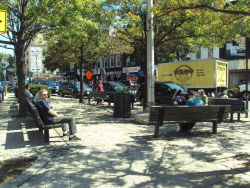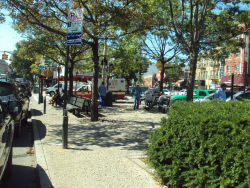Sgt. Joyce Kilmer Square
Joyce Kilmer Square
What was here before?
This site lies along Kings Highway. The Lenape established this road, called Mechawanienck, or Ancient Pathway, long before Europeans settled the area. By the mid-1600s, it was a major highway running through the towns of Brooklyn, Flatbush, Flatlands, Gravesend, and New Utrecht and it was formerly named Kings Highway in 1704.
How did this site become parkland?
The site was acquired when the abutting street layout design was changed in 1920. It became parkland in 1934 and named Sergeant Joyce Kilmer Square in 1935.
This park is lined with benches shaded by towering oak trees, with a flagpole along East 12th Street.
Who is this parkland named for?
The square is named for Sergeant Alfred Joyce Kilmer (1886-1918), a poet and soldier who died during World War I.
Born on December 6, 1886 in New Brunswick, New Jersey and educated at Rutgers Preparatory School, Kilmer attended both Rutgers University and Columbia University before earning his degree from Columbia in 1908. In 1908, Kilmer married another poet, Aline, and they had four children. After teaching Latin for a year at Morristown High School in New Jersey, Kilmer began his career in 1909 as a dictionary editor with Funk & Wagnall’s Company. In 1912, he served as the Literary Editor of The Churchman, an Anglican newspaper, also contributing freelance articles and poems to several other publications. Soon after joining the staff of the New York Times in 1913, Kilmer converted to Catholicism.
Joyce Kilmer was considered America’s premier living Catholic poet. His 1913 poem “Trees,” which millions of children learned by heart, was so loved that his mother put it into a song cherished by the entire country.
In 1917, when the United States declared war on Germany, Kilmer enlisted as a private in the 7th Regiment of the New York National Guard. With the help of Father Duffy (1871-1932), he transferred to the 165th Infantry, the “Fighting Irish.” In France, Kilmer quickly rose in the ranks to Sergeant and was assigned to the Regimental Intelligence staff as an observer, spending many nights on patrol gathering information in No Man’s Land. While stationed there, he also wrote for Stars and Stripes, the Army weekly.
On July 30, 1918, Kilmer was mortally wounded by a sniper’s bullet during the second Battle of the Marne and died later that day in the village of Seringes. He is buried in the Oise-Aisne American Cemetery and Memorial, near Fere-en-Tardenois, France. Kilmer was awarded the Croix de Guerre by France.
I think that I shall never see
A poem lovely as a tree.
A tree whose hungry mouth is pressed
Against the earth’s sweet flowing breast;
A tree that looks at God all day
And lifts her leafy arms to pray;
A tree that may in summer wear
A nest of robins in her hair;
Upon whose bosom snow has lain
Who intimately lives with rain.
Poems are made by fools like me,
But only God can make a tree.
Check out your park's Vital Signs
Clean & Safe
Green & Resilient
Empowered & Engaged Users
Share your feedback or learn more about how this park is part of a
Vital Park System



